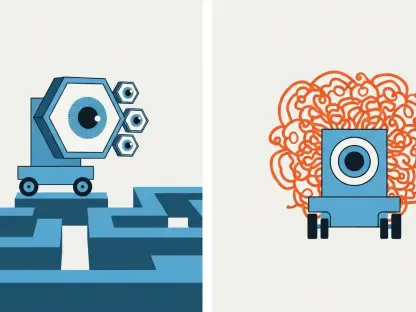In an era where technology permeates every aspect of daily life, the sacred realm of religious ministry finds itself at a crossroads with the advent of Artificial Intelligence (AI). The notion of AI-crafted sermons has ignited a profound debate among clergy and theologians, raising a pivotal question: can a machine replicate the spiritual depth and personal connection that have long defined a pastor’s message to their congregation? This dilemma is not merely about technological capability but touches on the essence of what it means to minister in a world increasingly shaped by digital tools. As AI promises efficiency and access to vast resources, it also challenges the traditional boundaries of human interaction in faith settings. The discussion is complex, weaving together ethical concerns, practical benefits, and the enduring tension between innovation and tradition. Delving into this topic reveals a landscape where faith communities are grappling with how to integrate cutting-edge tools without losing the heart of their mission.
The Ethical Debate Around AI in Ministry
Authenticity and the Human Connection
The heart of the ethical debate surrounding AI in ministry lies in the concern over authenticity and the irreplaceable human connection that sermons embody. Sermons are not just speeches; they are deeply personal expressions of faith, often drawn from a pastor’s own struggles, joys, and intimate understanding of their congregation’s needs. Critics argue that AI, despite its sophistication, cannot capture the emotional nuances or lived experiences that give a sermon its power to inspire and heal. A machine lacks the capacity to empathize with a grieving family or to reflect on personal spiritual growth, elements that often shape a message’s resonance. This perspective holds that the source of a sermon matters profoundly, as the human touch is seen as a conduit for divine inspiration, something an algorithm cannot replicate. The fear is that relying on AI could reduce sacred communication to a mechanical process, stripping away the soul of ministry.
Another layer of this concern focuses on the relational trust between pastor and congregation, which could be undermined by AI-generated content. When a pastor delivers a sermon, it often carries the weight of their personal journey with scripture and their role as a spiritual guide within the community. If congregants were to learn that a message was crafted by a machine, even in part, it might erode the sense of intimacy and authenticity that defines their bond with their leader. Scholars and clergy alike emphasize that ministry is fundamentally about relationships, not just information delivery. The idea of a sermon being produced by code raises questions about whether the spiritual authenticity of the message can remain intact without the pastor’s personal investment. This debate underscores a broader anxiety about technology’s role in diluting human connection in spaces meant to nurture the soul.
Tradition vs. Technological Progress
The clash between maintaining sacred traditions and embracing technological progress forms another critical dimension of the AI debate in ministry. For centuries, religious practices have been rooted in rituals and personal interactions that prioritize human involvement over mechanization. Many within faith communities view the introduction of AI as a potential threat to these time-honored customs, fearing it could transform the pulpit into a platform for impersonal, automated content. The concern is that adopting such tools might prioritize convenience over the spiritual discipline required to craft a sermon through prayer and reflection. This resistance reflects a broader unease about whether technology, even when beneficial, aligns with the core values of faith, which often emphasize human imperfection and divine connection over flawless efficiency.
Yet, there is also a counterargument that draws on historical precedents to frame AI as a natural evolution in religious practice. Just as the printing press revolutionized the dissemination of sacred texts centuries ago, enabling broader access to scripture, AI could be seen as a modern tool to enhance ministry. Proponents suggest that technology has always played a role in faith, from organs enhancing worship to online streaming expanding reach. They argue that resistance to AI might mirror past hesitations about innovations that eventually became integral to religious life. This perspective encourages a balanced view, recognizing that while tradition holds immense value, progress can offer new ways to fulfill the mission of spreading spiritual messages. The challenge lies in ensuring that such advancements support rather than overshadow the human essence of faith.
Practical Implications of AI in Sermon Preparation
Efficiency and Time-Saving Benefits
One of the most compelling arguments for integrating AI into sermon preparation is its potential to significantly boost efficiency. With the ability to access and analyze vast databases of theological texts, historical sermons, and scriptural interpretations in mere seconds, AI offers a resource that no single pastor could match in terms of speed or breadth. This capability could save countless hours of research, a precious commodity for clergy who often juggle multiple responsibilities beyond preaching, such as administrative tasks and community outreach. By streamlining the preparation process, AI might enable pastors to dedicate more time to direct pastoral care, whether through counseling, visiting the sick, or engaging in personal interactions with congregants. This shift could arguably enhance the quality of ministry by refocusing efforts on the relational aspects that many consider the true core of their calling.
Beyond time savings, AI’s capacity to provide diverse perspectives and historical context can enrich sermon content in unique ways. For instance, it can pull insights from obscure texts or lesser-known theological debates, offering fresh angles that might not emerge from a pastor’s individual study. This could be particularly beneficial for smaller congregations or overworked clergy who lack access to extensive libraries or academic resources. However, the emphasis remains on using AI as a supplementary tool rather than a primary source. The potential for enhanced content must be weighed against the need for personal interpretation, ensuring that the final message still reflects the pastor’s voice and spiritual insight. The promise of efficiency is undeniable, but it must be harnessed thoughtfully to avoid diminishing the personal investment that sermons traditionally demand.
Risks of Over-Reliance on AI
While the efficiency of AI is appealing, there are significant risks associated with over-reliance on such technology in sermon preparation. A primary concern is the potential loss of the formative process that comes with crafting a sermon through personal study and reflection. Many theologians argue that the labor of wrestling with scripture, confronting doubts, and seeking divine guidance is not just a means to an end but a vital part of a pastor’s spiritual growth. This struggle shapes their understanding and deepens their connection to the message they deliver. If AI were to take over this process, it might rob clergy of an essential aspect of their vocation, reducing sermon creation to a transactional task rather than a transformative journey. The worry is that pastors could become mere conduits for machine-generated content, losing the depth that comes from personal engagement with faith.
Additionally, there is a fear that over-dependence on AI might dilute the spiritual authenticity of ministry as a whole. Sermons often resonate because they address the specific joys, pains, and needs of a congregation, insights that stem from a pastor’s direct experience with their community. An algorithm, no matter how advanced, cannot replicate the empathy or contextual understanding required to tailor a message to a unique audience. This raises concerns about whether AI-generated content, even if polished and theologically sound, can truly meet the emotional and spiritual demands of a congregation. The risk of creating generic or disconnected sermons looms large, potentially alienating listeners who seek a personal touch. As such, the integration of AI must be approached with caution to preserve the heartfelt authenticity that defines effective preaching.
Navigating the Future of AI in the Church
Lack of Consensus and Guidelines
As AI continues to make inroads into religious spaces, a striking challenge is the lack of consensus and formal guidelines within faith communities regarding its use. Major denominations have yet to establish clear policies on whether or how AI should be incorporated into sermon preparation or delivery. While some clergy express openness to using AI as a research aid, others remain deeply skeptical of its appropriateness in a sacred context. This absence of unified direction leaves individual pastors to navigate a complex ethical landscape on their own, often relying on personal judgment to balance the benefits of technology with the sanctity of their role. Without structured guidance, there is a risk of inconsistent application, where some may embrace AI fully while others reject it outright, potentially creating disparities in how ministry is practiced across congregations.
The lack of consensus also highlights broader uncertainties about technology’s role in spiritual life. Surveys indicate that only a small fraction of clergy feel comfortable using AI for sermon writing, though a larger percentage see value in its research capabilities. This divide reflects not just differing views on AI itself but also varying interpretations of what constitutes authentic ministry. Until religious bodies develop comprehensive frameworks to address these issues, the burden of decision-making falls on individual leaders, who must weigh innovation against tradition without a clear roadmap. This situation underscores the urgency for dialogue within denominations to establish boundaries and best practices, ensuring that AI serves as a tool to enhance rather than disrupt the spiritual mission of the church.
Historical Perspectives and Future Outlook
Reflecting on the past offers valuable insights into how religious communities might approach AI in ministry. History shows that faith has often adapted to technological advancements, from the adoption of the printing press to the use of digital platforms for worship. These shifts, though initially met with resistance, eventually became integral to spreading spiritual messages and engaging wider audiences. Scholars suggest that the current debate over AI mirrors these past tensions, indicating that acceptance may grow as its implications become clearer over time. This perspective encourages patience, recognizing that integration does not need to be immediate but can evolve through careful consideration of both benefits and drawbacks. The key is to learn from history while remaining attentive to the unique challenges AI presents in a sacred context.
Looking ahead, there is a strong call for a measured approach to evaluating AI’s long-term impact on faith and ministry. Many experts advocate for a wait-and-see stance, allowing time to assess how this technology shapes spiritual practices before it becomes widely adopted. This cautious outlook emphasizes the need for ongoing research and discussion within religious communities to understand AI’s systemic effects on congregational life and pastoral roles. Rather than rushing to implement AI tools, there is value in observing how early adopters fare and whether their experiences reveal unforeseen consequences. The future of AI in the church will likely depend on developing thoughtful strategies that prioritize human connection while leveraging technology’s potential, ensuring that ministry remains a deeply personal and transformative endeavor for all involved.









